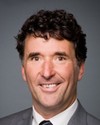Thank you. It's a pleasure to be here.
Just a few words about me. My name is Anja Jeffrey. I'm a Danish national, but I live in Canada now. My background is in foreign policy. I was a career diplomat with the Danish foreign service for 17 years. I've had two overseas postings, one in the United States in the 1990s, and from 2003 to 2007, as the deputy ambassador to Canada. I lived in Ottawa for four years as a career diplomat, getting to know the country, its policies and politics, and its various regions very well, to the extent that we fell in love with the country and decided to come and live here permanently. In 2009, we immigrated, and I've been living in Canada with my husband and my children since then.
My background is varied. I have a bachelor's in business administration and a master's in international relations. Since I came to work in Canada, I have been primarily preoccupied with circumpolar issues and with the north, both from an economic and a social perspective. When I returned to Denmark in 2007, I became the director for our Arctic resources management committee, or management unit, and one of my files was seals, negotiating the EU seal ban—not that we were promoting the ban; we were negotiating on behalf of Greenland, and were trying to the best of our ability to work against the ban.
In 2009, when I came, I started to work for the Canadian government, and in 2011 I landed the job I have now as the director of the Centre for the North at the Conference Board of Canada. I will tell you a little about the centre.
I have a 10-minute statement, which is written down, so it can be circulated afterwards and picked up, if need be. I'll read that and make those linkages between domestic and foreign policy that I think are extremely important. I would be very open to answering your questions afterwards.
First, a little about my centre. The Centre for the North brings aboriginal leaders, businesses, governments, academia, and communities together, providing a balanced matrix of dialogue in Canada on northern issues. We at the centre deliver cutting-edge research, based on three foundational themes of thriving communities, economic development, and sovereignty and security in Canada's north. Our research is north-centric. It focuses on northern needs and wants. We have published reports on innovative pathways to education in the north, on labour force capacity issues, and on understanding the impacts of major resource projects.
Biannually, we issue an economic forecast for the territories. On Monday we are releasing a report on sustainable options for housing in the north, a highly sensitive issue and one where smart projects are now leading the way to better housing solutions both on and off reserve. Our work fills important information and data gaps in Canada. We provide accurate, in-depth, and consistent information to people across Canada about the northern potential and where it's going.
My testimony to the committee today will focus on the human dimension of Arctic foreign policy. Why is that? All our research consistently points to the fact that resilient and thriving northern communities are the key to unlocking the tremendous economic potential of the north and to moving the northern agenda forward. The centre's research report, “Getting it Right: Assessing and Building Resilience in Canada's North”, confirms that rather than being too concerned about Arctic sovereignty and national security issues, northerners want to live in secure, prosperous, and self-reliant communities. There is an obvious causal link: resilient communities equal an economically sustainable Arctic region, equal a robust Arctic foreign policy based on the inherent strength of northerners.
Resilience refers to the capacity of a community to anticipate risk, limit impact, and recover rapidly in the face of change. By today's standards, many northern communities, particularly aboriginal ones, are not resilient. Rapid socio-economic changes brought on by mine openings or closures—the boom and bust cycle—remoteness and infrastructure gaps, and a lack of economic diversity make building community resilience a daunting task for northerners.
Without question, one of the most acute risks facing northerners is climate change and its related consequences. For example, climate change is severely affecting the northern housing stock. Houses are deteriorating at a much faster rate than those in the south and are far more expensive to operate. Add overcrowding and you have a ticking time bomb on your hands. In Nunavut, 25% of homes have six or more people living in them; in northern Manitoba, that number is 20%.
Our comprehensive report on housing in the north recommends integration of technology and innovation in northern housing designs to offset climatic factors and reduce operating and maintenance costs.
We believe that strong policy measures are needed to drive and foster northern resilience. Rather than trying to bolster resilience from the top down, policy makers must instead formulate strategies that enable locally driven resilience-building measures. One way of doing that is to work with communities to first identify their specific risks and strengths, and their capacity to respond, and then to craft recovery and implementation plans that work on the ground. This is a way of empowering people to take action and break the cycle.
Building off our report on resilience, we are developing a pilot project in collaboration with an aboriginal community in the Northwest Territories to address social emergencies and natural disasters that may impact their community in the future.
To sum up, in terms of foreign policy impacts, it's important to stress that a healthy and resilient north is a north that can effectively drive Canadian sovereignty and security. Asserting Canadian sovereignty, outside military operations or the Rangers, requires that we continue to maintain populations in even the most remote areas. If people move away because of lack of economic opportunities or dismal social conditions, we cannot ensure consistent monitoring of our sovereign territory. So we need to invest in people and their communities. In essence, promoting Canada's northern strategy abroad starts at home, with a good understanding of the challenges and opportunities faced by northerners and adequate measures to address them.
I have brought copies of the report that I'm referencing in my presentation, “Getting it Right: Assessing and Building Resilience in Canada's North”. It's also available from our website, centreforthenorth.ca.
Thank you.




